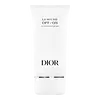What's inside
What's inside
 Key Ingredients
Key Ingredients

 Benefits
Benefits

 Concerns
Concerns

 Ingredients Side-by-side
Ingredients Side-by-side

Water
Skin ConditioningGlycerin
HumectantLauric Acid
CleansingStearic Acid
CleansingSodium Methyl Cocoyl Taurate
CleansingMaltooligosyl Glucoside
Skin ConditioningPalmitic Acid
EmollientSodium Hydroxide
BufferingHydrogenated Starch Hydrolysate
HumectantParfum
MaskingGlyceryl Stearate
EmollientPEG-100 Stearate
Pentaerythrityl Tetrabehenate
EmollientNymphaea Alba Root Extract
Skin ConditioningDipotassium Glycyrrhizate
HumectantCoco-Betaine
CleansingPotassium Hydroxide
BufferingChlorphenesin
AntimicrobialSodium Cocoyl Isethionate
CleansingSodium Benzoate
MaskingPotassium Sorbate
PreservativeTocopherol
AntioxidantCitric Acid
BufferingCaprylyl Glycol
EmollientPolyquaternium-22
Water, Glycerin, Lauric Acid, Stearic Acid, Sodium Methyl Cocoyl Taurate, Maltooligosyl Glucoside, Palmitic Acid, Sodium Hydroxide, Hydrogenated Starch Hydrolysate, Parfum, Glyceryl Stearate, PEG-100 Stearate, Pentaerythrityl Tetrabehenate, Nymphaea Alba Root Extract, Dipotassium Glycyrrhizate, Coco-Betaine, Potassium Hydroxide, Chlorphenesin, Sodium Cocoyl Isethionate, Sodium Benzoate, Potassium Sorbate, Tocopherol, Citric Acid, Caprylyl Glycol, Polyquaternium-22
Microcrystalline Cellulose
AbsorbentOryza Sativa Powder
Sodium Lauryl Phosphate
EmulsifyingSodium Lauroyl Glutamate
Sodium Stearoyl Glutamate
CleansingWater
Skin ConditioningSodium Cocoyl Glutamate
CleansingLauryl Betaine
CleansingSodium Lauroyl Methylaminopropionate
CleansingCamellia Sinensis Leaf
PerfumingPapain
Skin ConditioningOryza Sativa Bran Extract
Skin ConditioningPropanediol
SolventDextrin
AbsorbentEthylhexylglycerin
Skin ConditioningKaolin
AbrasiveTocopherol
AntioxidantPhytosteryl/Octyldodecyl Lauroyl Glutamate
Skin ConditioningDipotassium Glycyrrhizate
HumectantSilica
AbrasiveButylene Glycol
HumectantPhenoxyethanol
PreservativeCI 77492
Cosmetic ColorantCI 77007
Cosmetic ColorantMicrocrystalline Cellulose, Oryza Sativa Powder, Sodium Lauryl Phosphate, Sodium Lauroyl Glutamate, Sodium Stearoyl Glutamate, Water, Sodium Cocoyl Glutamate, Lauryl Betaine, Sodium Lauroyl Methylaminopropionate, Camellia Sinensis Leaf, Papain, Oryza Sativa Bran Extract, Propanediol, Dextrin, Ethylhexylglycerin, Kaolin, Tocopherol, Phytosteryl/Octyldodecyl Lauroyl Glutamate, Dipotassium Glycyrrhizate, Silica, Butylene Glycol, Phenoxyethanol, CI 77492, CI 77007
 Reviews
Reviews

Alternatives
Ingredients Explained
These ingredients are found in both products.
Ingredients higher up in an ingredient list are typically present in a larger amount.
Dipotassium Glycyrrhizate comes from licorice root.
Extracts of licorice have demonstrated to have antibacterial, anti‐inflammatory, antiviral, antioxidant properties.
One component, glabridin, has extra potent antioxidant and soothing properties. It has also been found to block pigmentation from UVB rays in guinea pigs.
Licorice Root also contains a flavonoid. Flavonoids are a natural substance from in plants. Flavonoids also have antioxidant properties.
Another component, glycyrrhizin, has been found to have anti-inflammatory and antimicrobial benefits. This may make licorice root extract effective at treating acne. However, more research is needed to support this.
Liquiritin is one of the flavone compounds found in licorice. It has been found to help lighten skin by preventing tyrosinase from reacting with tyrosine. When the two react, protein is converted to melanin. Melanin is the substance in your body that gives your features pigmentation.
Licorice root is native to Southern Europe and Asia. It has been used in traditional Chinese medicine to help with respiratory issues.
Learn more about Dipotassium GlycyrrhizateTocopherol (also known as Vitamin E) is a common antioxidant used to help protect the skin from free-radicals and strengthen the skin barrier. It's also fat soluble - this means our skin is great at absorbing it.
Vitamin E also helps keep your natural skin lipids healthy. Your lipid skin barrier naturally consists of lipids, ceramides, and fatty acids. Vitamin E offers extra protection for your skin’s lipid barrier, keeping your skin healthy and nourished.
Another benefit is a bit of UV protection. Vitamin E helps reduce the damage caused by UVB rays. (It should not replace your sunscreen). Combining it with Vitamin C can decrease sunburned cells and hyperpigmentation after UV exposure.
You might have noticed Vitamin E + C often paired together. This is because it is great at stabilizing Vitamin C. Using the two together helps increase the effectiveness of both ingredients.
There are often claims that Vitamin E can reduce/prevent scarring, but these claims haven't been confirmed by scientific research.
Learn more about TocopherolWater. It's the most common cosmetic ingredient of all. You'll usually see it at the top of ingredient lists, meaning that it makes up the largest part of the product.
So why is it so popular? Water most often acts as a solvent - this means that it helps dissolve other ingredients into the formulation.
You'll also recognize water as that liquid we all need to stay alive. If you see this, drink a glass of water. Stay hydrated!
Learn more about Water